Menus
- Autonomous camera to be mounted on a motorcycle
- In recent years, stand-alone cameras for making on-board video have multiplied and are more and more accessible. The GoPro has become a benchmark.
- Discovery
- Test
- Convenient
- Conclusion
Autonomous camera to be mounted on a motorcycle
In recent years, stand-alone cameras for making on-board video have multiplied and are more and more accessible. The GoPro has become a benchmark.
The breach was opened by the atc2k (Oregon), of average quality, but which allowed many bikers to have their first experience. Dreaming about the views on board in MotoGP for a long time, I fell in love first with the Atc2k, then more recently with the GoPro Hero Wide.

Released in "normal" version in 2007, then in "Wide" version in 2009, it then appeared in "Wide HD" version. I have set my sights on the normal Wide version … simply because my PC is not powerful enough to process HD video.
The main difference between these 2 models, apart from the definition, comes from the operation on 2 AAA batteries for the normal version, and on a specific battery for the HD version. The HD is also a little larger (a few mm) than the basic version.
The price difference also plays a role since we go from 170 € to 350 € in HD version.
Discovery
As soon as the package is opened (I ordered my GoPro in Germany), the quality of finish and presentation is obvious.
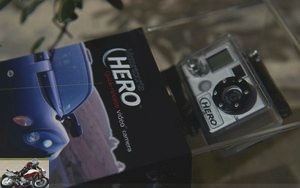
A rather classy black box contains the accessories. It is surmounted by a plastic cover closed by a support on which the camera is screwed..
The model I have chosen is the "Motorsport Hero Wide", which is a priori the most suitable for motorcycles.
In the box, in addition to the camera and its case (thick waterproof transparent plastic shell), there is a high resistance suction cup, 3 self-adhesive supports flat, 2 curved sticker mounts (for a helmet), parts to build a articulated arm to orient the camera as desired and a cable to unload the videos. You must add 2 batteries (high capacity rechargeable batteries recommended) type AAA and an SD card.

Self-adhesive mounts can be attached anywhere on the motorcycle: fairing, rear fender, front fender…
The self-adhesive backing looks like a black plastic piece, with a foam coated with an adhesive. A movable part on which the camera is mounted is clipped onto it, which allows it to be oriented correctly. Of course, unlike the suction cup, this support is fixed and cannot be removed and put back on all the time. You place it only once (and you can of course remove it afterwards but it is not reusable).
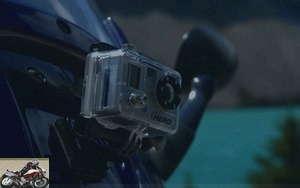
The camera offers a viewing angle of 170 °, which makes it possible, for example, to fix the camera on a seat backrest and not only see the rider’s buttocks, but also the edges of the track.
Once the batteries are charged, we quickly go through the manual. It only takes a few minutes to understand how the camera works. A button to turn on or off (long press) and move through the menus (short press), and a button to start / stop filming or take pictures when in photo / camera mode, which is also used to change the parameters in the menus. Said like that, it may sound complicated, but believe me, it’s super simple.
Test
Well, the time for the first test has come; That’s good, I have a taxi to Vigeant planned. So I stick on the backsplash of the VFR one of the flat self-adhesive fasteners. It attaches very well, it is important not to miss positioning it, it is impossible to move it afterwards, if we miss each other, it’s dead.
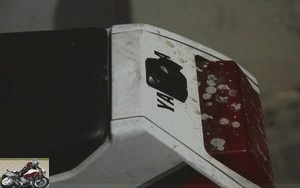
In the menus, I switch to HI mode (we have the choice between HI and LO quality), and let’s go for a rear view, just to see the people I drop off. 25 minutes later, I return to the pits, and transfer the video.
The picture is very good, but the sound is saturated. It is written in the manual that for the motorbike or external sockets in mechanical sport that it is better to put in LO mode. I test during the 2nd session, it doesn’t change much for the image, on the other hand, in terms of sound, it’s day and night. It hardly saturates any more, we can hear the engine well, not too much the wind, perfect. Well, you have to keep in mind that it’s a product that costs around 170 euros, so we won’t have the quality of MotoGP paws, but it allows you to bring back some great memories. These first tests are below.
The self-adhesive fixing has passed the 1st test and the camera too. With 2 850 mah batteries, I was able to shoot about 1 hour, knowing that it was hot (the batteries run down faster when it’s cold).
The curved attachment is intended for a helmet (for example), but I couldn’t really see myself attaching one to my motorcycle helmet. Already I do not think that I am allowed to enter the track with that, and in the event of a fall, I dare not imagine the risk.
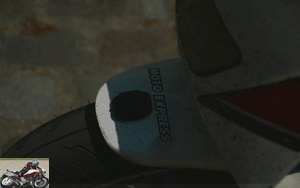
The suction cup test will take place a little later, during a weekend in the Drome, then in the Vosges. To change the rear views, I suck the camera on the side of the fairing.
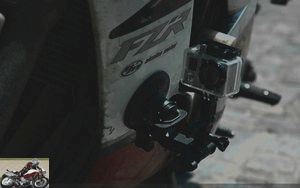
There are a few precautions to follow. The fairing should be wiped down to remove dust, if possible avoid sucking on a sticker, and choose the flatest place possible. Anyway, with the articulated arm system, it is quite easy to orient the camera correctly..
For the first few kilometers, I kept a worried eye on the camera to make sure it didn’t come off, but I quickly realized that I didn’t have to worry. You just have to fix the suction cup by pushing the piston as far as it will go, then turn the lever provided for this purpose to increase the pressure, and it holds. !
I made several hundred kilometers with the camera on the side: no worries.
In terms of images, it’s quite impressive. The camera is placed low enough and because of the angle of view, we see the front wheel, a piece of fairing, and the "scenery" which scrolls quickly on the side. The impression of speed is deceptive, even when driving quietly, we have the impression of driving at a good pace, the angles are accentuated. It really gives beautiful images.
You just have to remember to stop to start the camera, because after a few minutes without filming, it switches off automatically to save the batteries. And it is not possible to turn it back on without seeing the screen.
But the suction cup holding very well, I only took off the camera during the stages, so I only made short pauses while turning on and starting the camera at the beginning of the interesting portions. Some examples on the road are also visible below.
Convenient
It is possible to order additional bindings online, which I also did. I tested a handlebar mount, originally intended for a mountain bike, but which can be easily attached to a roadster or a supermotard, or even a bar end. I tested this binding in downhill mountain biking, the image is good, does not jump too much, and the impression of speed is real, especially if you tilt the camera a little forward, which allows you to see the wheel spinning. In addition, having the camera close at hand makes it easy to turn it on and off. The support that screws around the handlebars prevents any risk of losing the camera, and in TT, can therefore be more interesting than the suction cup.
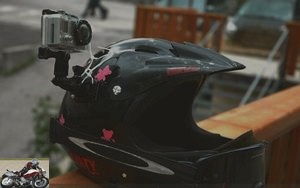
My last test was to attach a curved sticker mount to a helmet. As said above, I didn’t see myself riding a motorbike with it, but on a bike (always downhill), why not. It is advisable to wait 24 hours after gluing the support, to be sure that the glue has set. I had also secured the assembly with Rilsan collars, unnecessary precaution, the camera did not move. Once the helmet is on your head, you can feel the excess weight on the side, but very slightly. In bumps and on damaged terrain, we feel that the helmet tends to "pull" on the side of the camera. Nothing really annoying, but in my opinion, on the road, with the pressure of the wind, the helmet may turn on its own. Again, the images are very cool. We can see the side of the visor of the helmet, and the track that scrolls, with the addition of the possibility of watching the little friends who follow or ride alongside, and therefore to film them.
The box which contains the camera is noted as being "waterproof", I have not tested in immersion, but I did a hundred kilometers in the pouring rain with the camera on the motorcycle, as well as several mountain bike descents under the snow and rain, no worries, humidity and water do not enter.
Conclusion
You will easily understand that I have become addicted to this toy, which allows you to film anywhere, all the time, with little or no preparation. 2 batteries, an SD card, we glue or suction the support and the films worthy of the motogp…. or almost .
Strong points
- Ease of use
- Compact
- Image quality, even for the normal version
Weak points
- Autonomy does not exceed 1 hour with new batteries
- The sound saturates for the motorcycle in HI mode
- The prohibitive price in France
Related articles
-
The four-wheel scooter Finally the Quadro4 arrives and doubly deserves its name now since it took almost four years to see it arrive with its four wheels…
-
1731 cc, 89 hp, 139 Nm of torque, 296 dry kilos, € 13,490 An affordable, engaging and efficient power-cruiser with a very healthy chassis Mid-90s:…
-
Discovering the…. thing …. Canadian Neither motorcycle, nor trike, nor auto roadster … The BRP Can Am Spyder is a bit of all of this at the same time…
-
French luxury What if the rebirth of our motorcycle industry went through the high end? The approach is relevant and deserves attention. In any case,…
-
Indian Chieftain Limited Trial
The bagger is updated with aesthetic and mechanical evolutions V2, 1811 cm3, 84 hp at 5000 rpm, 150 Nm at 2100 rpm, 364 kilos dry, from € 28,850 With the…
-
Single cylinder, 411 cc, 24.5 hp at 6,500 rpm, 32 Nm at 4,000 rpm, 185 kilos, from € 4,495 A small, economical and versatile single-cylinder trail runner…
-
The three-wheeler accessible in its 600 and 900 Rotax versions Should we still present the or rather the Can-Am, especially in France, which represents…
-
Cambox MKV3 helmet camera test
A miniature action camera that can be installed in the helmet FullHD 1080p at 30 fps, 40 grams, 1h15 of autonomy, 12 MP photo, WiFi, 35 ° tilt, vibrating…
-
A complement to the Chief range: the 1811 cm3 light tourer, at € 27,000 Easily removable windshield and hard saddlebags, cruise control as standard, 372…
-
Brough Superior Anniversary Trial
Birthday bling bling 88 ° V-Twin of 997 cm3, 102 hp and 87 Nm, 186 kg dry, Fior fork, titanium frame … 100,000 € To celebrate its centenary in 2019,…